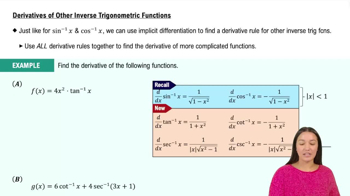Derivatives
In Exercises 1–18, find dy/dx.
y = (sec x + tan x)(sec x − tan x)
 Verified step by step guidance
Verified step by step guidance Verified video answer for a similar problem:
Verified video answer for a similar problem:



 3:53m
3:53mMaster Derivatives of Sine & Cosine with a bite sized video explanation from Patrick
Start learning